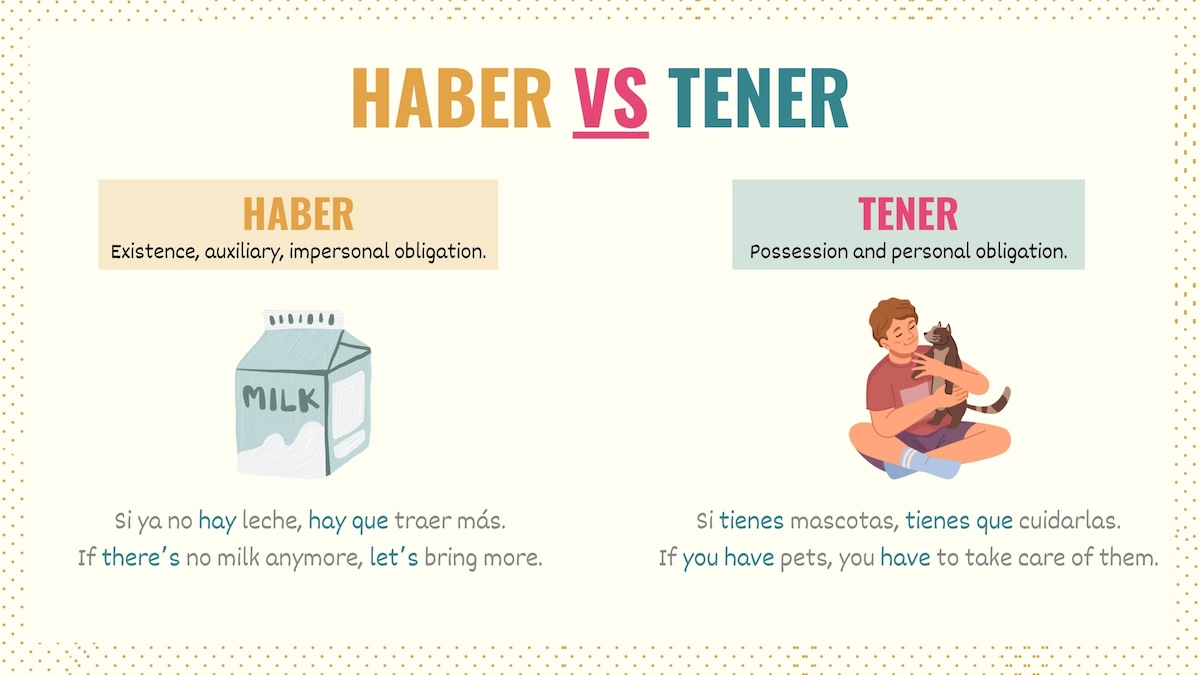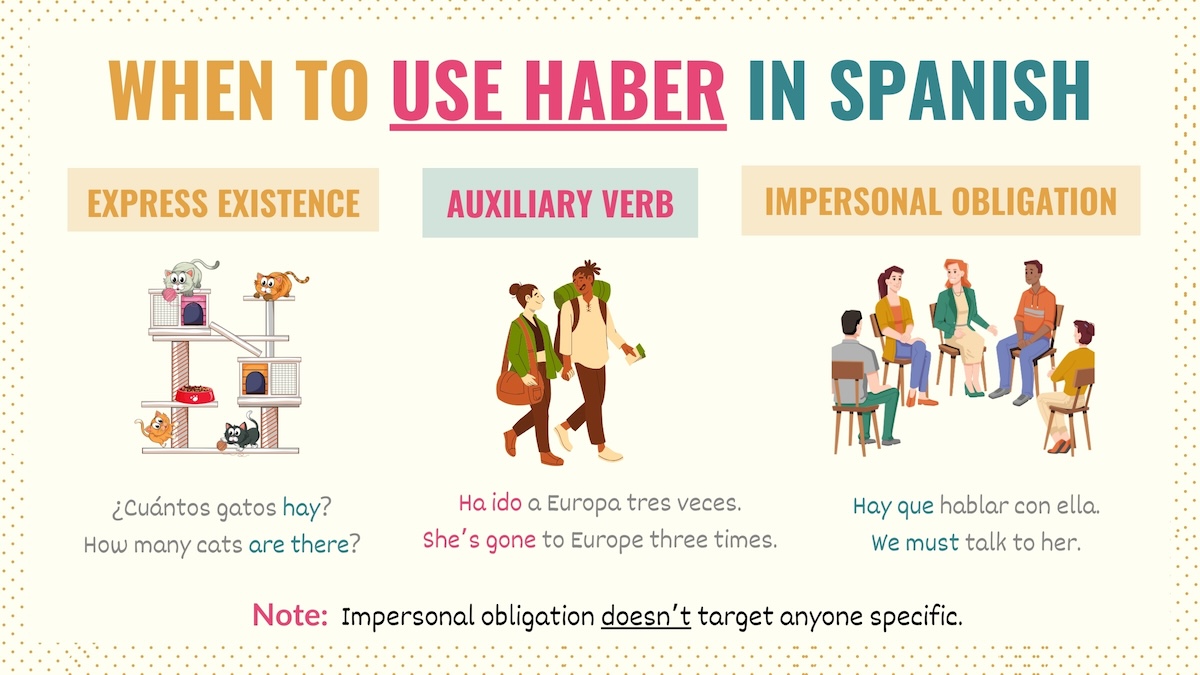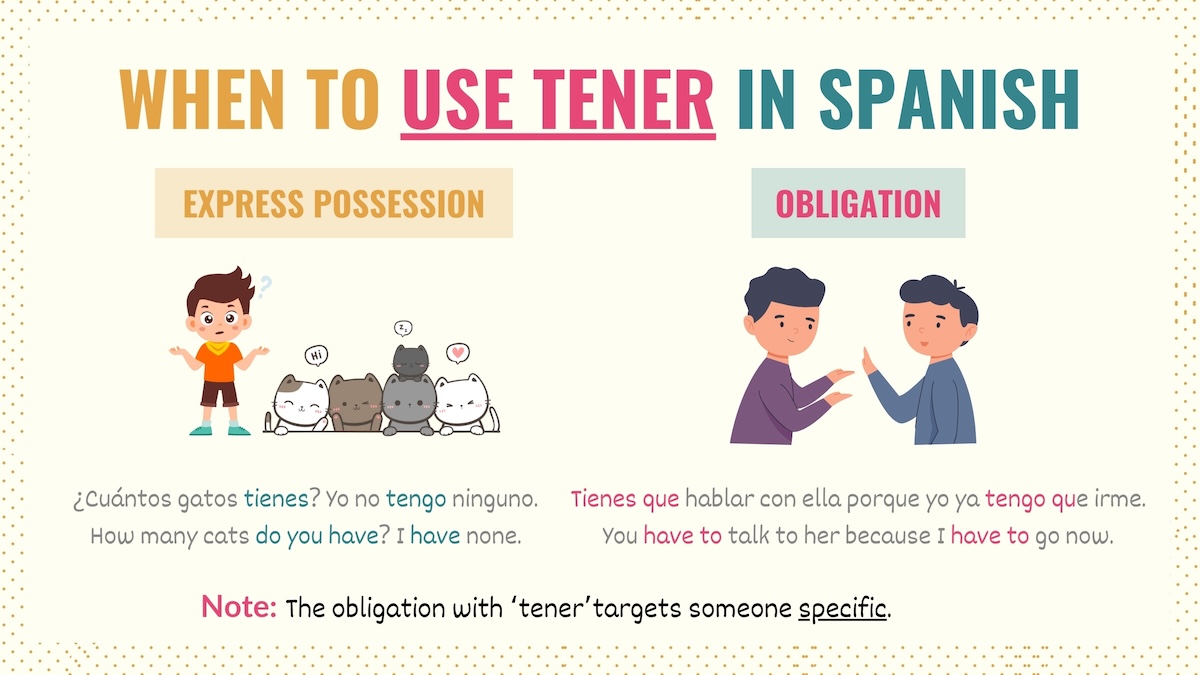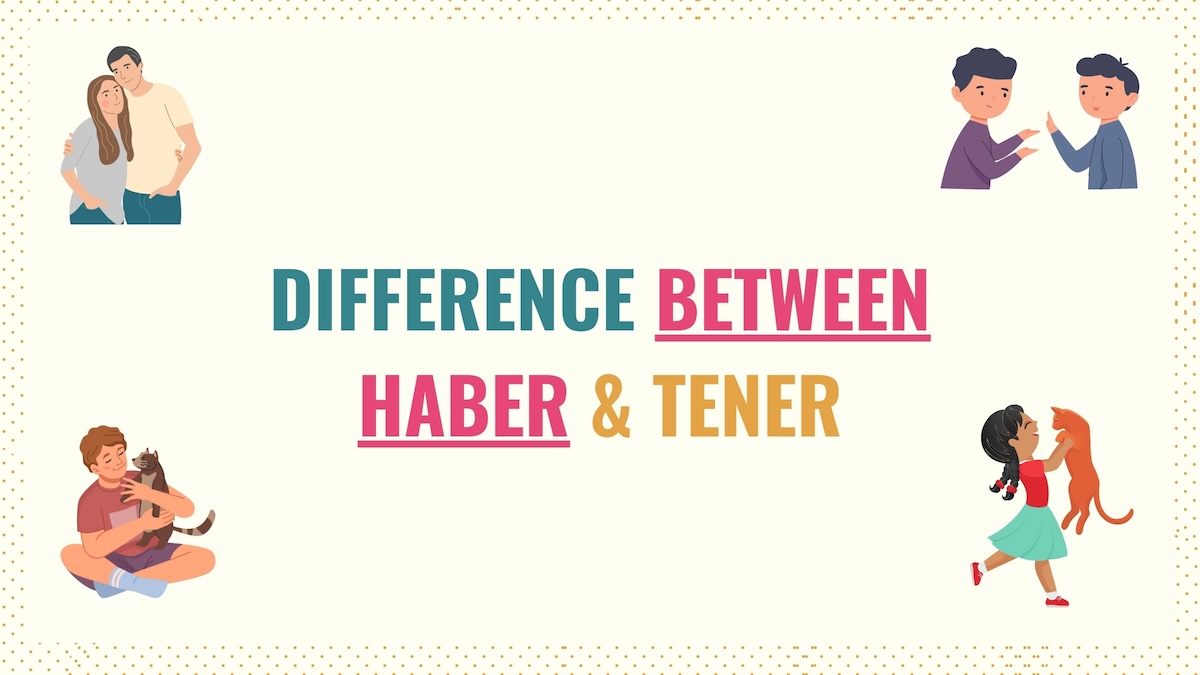As key Spanish verbs, mastering the haber vs tener topic is crucial to have effective conversations in Spanish. Son, in this article, you’ll learn the differences and uses of these verbs.
Tener vs Haber: What’s the Difference?

In Spanish, tener is used to express possession and obligations when it translates to ‘to have’. Haber conveys existence, impersonal obligation, and it’s mainly used as an auxiliary verb. So, depending on the context, can be translated as ‘to have’ or ‘there is/there are’.
Hay mucha comida en la mesa.
There’s a lot of food on the table.
¿Han visto a Sophie? Hay que invitarla a la fiesta.
Have you seen Sophie? Let’s invite her to the party.
No tenemos mucha comida, tenemos que comprar más.
We don’t have much food. We have to buy more.
To help you further understand the haber vs tener dilemma, in the following sections, we’ll discuss the applications of each verb and I’ll provide you with more examples.
When to Use Haber in Spanish?
There are three main ways to use the verb haber in Spanish:
- Express existence
- To talk about necessities or duties
- As an auxiliary verb

Expressing existence with haber
In Spanish, haber expresses the existence or presence of something in a place, regardless of whether that thing is plural or singular. To indicate this meaning, we must use the impersonal form hay.
Here are some examples:
Hay + [quantifier] + [noun]
Hoy no hay tanto tráfico.
Today, there’s not a lot of traffic.
¿Sabes si hay más leche?
Do you know if there is more milk?
En el centro, hay muchos museos y tiendas.
There are many museums and stores downtown.
Hay is in the present indicative form, which means that you must change it to refer to different tenses.
Fui al súper, pero no había leche.
I went to the grocery store, but there was no milk.
Haber as an auxiliary verb
One of the primary uses of haber is to form compound tenses, such as the present and past perfect. To conjugate these tenses, you must conjugate haber to match the tense you’re using and the past participle of the main verb:
[Haber conjugated] + [past participle]
¿Ya habías visto esa película?
Have you already seen that movie?
Carlos no ha terminado su tarea.
Carlos hasn’t finished his homework yet.
Tania y yo hemos ido a México varias veces.
Tania and I have gone to Mexico many times.
Express impersonal obligation
On top of expressing existence, the impersonal form hay is also used to express necessities or duties. This is known as impersonal obligations because we don’t conjugate to address someone in particular:
Hay que + [infinitive verb]
Hay que comprar los boletos mañana.
We need to buy the tickets tomorrow.
Oigan, hay que decirle a Claudia de la fiesta.
Hey, we need to tell Claudia about the party.
¿Qué vas a hacer mañana? Hay que ver una película.
What are you going to do tomorrow? We should watch a movie.
When to Use Tener
Even though, it can also be translated as ‘to have’, with this meaning, the verb tener is used to:
- Express obligation
- Indicate possession

Expressing possession
When expressing possession, it’s common to use quantifiers or numbers to express the amount of your or someone else’s belongings:
Tengo dos boletos para ir a Colombia.
I have two tickets to go to Colombia.
Mariana tiene un perro y tres gatos.
Mariana has one dog and three cats.
¿Tienes un borrador que me prestes?
Do you have an eraser that I can borrow?
Take Note: Tener is used to say someone’s age and also to form key idiomatic expressions.
Using ‘tener’ to express obligation
Similar to haber, tener is also used to express obligation. However, tener must be conjugated and express who is the person responsible for fulfilling that duty:
Tener que + [infinitive verb]
¿Cuándo tenemos que entregar el proyecto?
When do we have to deliver the project?
Yo tengo que hablar más español con mis amigos.
I have to speak more Spanish with my friends.
Mauricio tiene que pagar su boleto o no podrá viajar.
Mauricio has to pay his ticket or else he won’t be able to travel.
A main distinction in the haber vs tener topic is conveying obligation. Remember that duties we express with hay que are not directed to someone specific, whereas with tener we must conjugate to indicate who is obligated to fulfill the task:
Hay que estudiar más.
We must study more.
Tengo que estudiar más.
I have to study more.
Take Note: Keep in mind that the verb tener in Spanish has other applications that are not translated as ‘to have’.
Haber vs Tener Key Points
Because they can share the same translation, the verbs haber and tener can be easily confused. Here are some key differences you need to keep in mind:
- Haber is used as an auxiliary verb to form compound tenses (no he ido).
- Its impersonal form hay expresses the existence of something. In this context, haber means ‘there is’ or ‘there are’.
- Hay also conveys impersonal obligation. In other words, it indicates duties without addressing someone in particular.
- As the direct translation of ‘to have’, tener expresses possession.
- Tener also conveys obligation, but unlike haber, it does indicate who must fulfill a task.
Remember, tener has additional applications. That said, now you should be able to see the difference between haber and tener. ¡Buena suerte!
Watch the Haber vs Tener Video Lesson
Watch the Spanish Immersion Lesson!
Haber and Tener both mean ‘to have’ in Spanish, but are often confused and can be difficult for beginners to understand. You can watch the English explanation or opt to test your comprehension skills by watching the Spanish video lesson on Haber vs Tener.
Hopefully, now you have a better understanding of these verbs and you feel more confident to use them in your Spanish conversations.



